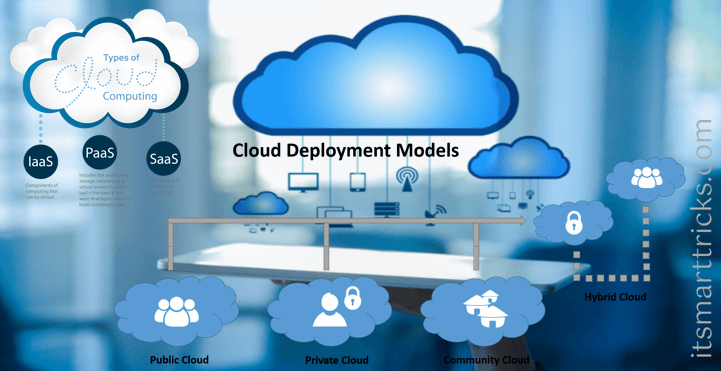There are 4 main types of cloud computing include private clouds, public clouds, hybrid clouds, and multiclouds. There are also 3 main types of cloud computing services: Infrastructure-as-a-Service (IaaS), Platforms-as-a-Service (PaaS), and Software-as-a-Service (SaaS).

Cloud computing is providing developers and IT departments with the ability to focus on the most important things and avoid separate tasks like purchasing, maintenance and capacity planning. As the popularity of cloud computing grows, many different models and deployment strategies have emerged to help meet the specific needs of different users. Each type of cloud service and deployment method, gives you different levels of control, flexibility and management. Understanding the differences between infrastructure as a service, platform as a service, and software as a service, as well as what deployment strategies you can use, can help you decide which set of services is right for your needs.
What’s different between public clouds, private clouds, hybrid clouds, and multiclouds:
Differences between public clouds, private clouds, hybrid clouds, and multicloud were once easily defined by location and ownership. But now it is not so easy. So when we compare the following differences, there are a lot of caveats.
- Public clouds:
Public clouds are cloud environments that are typically created from IT infrastructure that does not belong to the end user. Some of the largest public cloud providers include Alibaba Cloud, Amazon Mazon Web Services (AWS), Google Cloud, IBM Cloud and Microsoft Azure.
Traditional public clouds always ran off-premises, but today’s public cloud providers have started offering cloud services on clients’ on-premise data centers. This has made location and ownership distinctions obsolete.
All clouds become public clouds when the environments are partitioned and redistributed to multiple tenants. Fee structures aren’t necessary characteristics of public clouds anymore, since some cloud providers (like the Massachusettes Open Cloud) allow tenants to use their clouds for free. The bare-metal IT infrastructure used by public cloud providers can also be abstracted and sold as IaaS, or it can be developed into a cloud platform sold as PaaS.
- Private clouds:
Private clouds are collectively defined as cloud environments that are dedicated to only one end user or group, where the environment usually runs behind the firewall of that user or group. When the entire IT infrastructure is dedicated to a single customer with completely different access, all the clouds become private clouds.
- Hybrid clouds:
Hybrid Cloud is the only IT environment created from multiple environments connected by Local Area Networks (LANs), Wide Area Networks (WANs), Virtual Private Networks (VPNs), and / or APIs.
The characteristics of hybrid clouds are complex and the requirements can differ, depending on whom you ask. For example, a hybrid cloud may need to include:
- At least 1 private cloud and at least 1 public cloud.
- 2 or more private clouds.
- 2 or more public clouds.
- A bare-metal or virtual environment connected to at least 1 public cloud or private cloud.
But every IT system becomes a hybrid cloud when apps can go in and out of many separate – yet connected – environments. At least some of those environments need to be sourced from integrated IT resources that can grow on demand. And all of those environments need to be managed as a single environment using an integrated management and orchestra platform.
- Multiclouds:
Multiclouds are a cloud approach made up of more than 1 cloud service, from more than 1 cloud vendor – public or private. All hybrid clouds are multiclodes, but not all multiclods are hybrid clouds. Multiclodes become hybrid clouds when multiple clouds are combined in some form of aggregation or orchestration.
The multicloud environment may exist for the purpose (as unnecessary storage space for better control of sensitive data or for improved disaster recovery) or by accident (usually the result of shadow IT). Either way, having multiple clouds is becoming more common in industries trying to improve safety and performance through an expanded portfolio of environments.
Cloud services:
Cloud services are infrastructure, platforms, or software that are hosted by third-party providers and made available to users through the internet. There are 3 main types of as-a-Service solutions: IaaS, PaaS, and SaaS. Each facilitates the flow of user data from front-end clients through the internet, to the cloud service provider’s systems, and back—but vary by what’s provided.

Infrastructure as a Service (IaaS):
Infrastructure as a service (IaaS) are online services that provide high-level APIs used to dereference various low-level details of underlying network infrastructure like physical computing resources, location, data partitioning, scaling, security, backup etc.
Platform as a Service (PaaS):
Platform as a service (PaaS) or application platform as a service (aPaaS) or platform-based service is a category of cloud computing services that allows customers to provision, instantiate, run, and manage a modular bundle comprising a computing platform and one or more applications, without the complexity of building and maintaining the infrastructure typically associated with developing and launching the application and to allow developers to create, develop, and package such software bundles.
Software as a Service (SaaS):
Software as a service is a software licensing and delivery model in which software is licensed on a subscription basis and is centrally hosted. It is sometimes referred to as “on-demand software”, and was formerly referred to as “software plus services”
Also Read – What Is Cloud Computing? and Advantages of Cloud Computing
That’s all, In this article, we have explained Types of cloud computing. If you like this article, then just share it and then do subscribe to email alerts for Linux, Windows, macOS, Android, Internet, Firewall and Security, CCTV tutorials. If you have any questions or doubts about this article, please comment.
